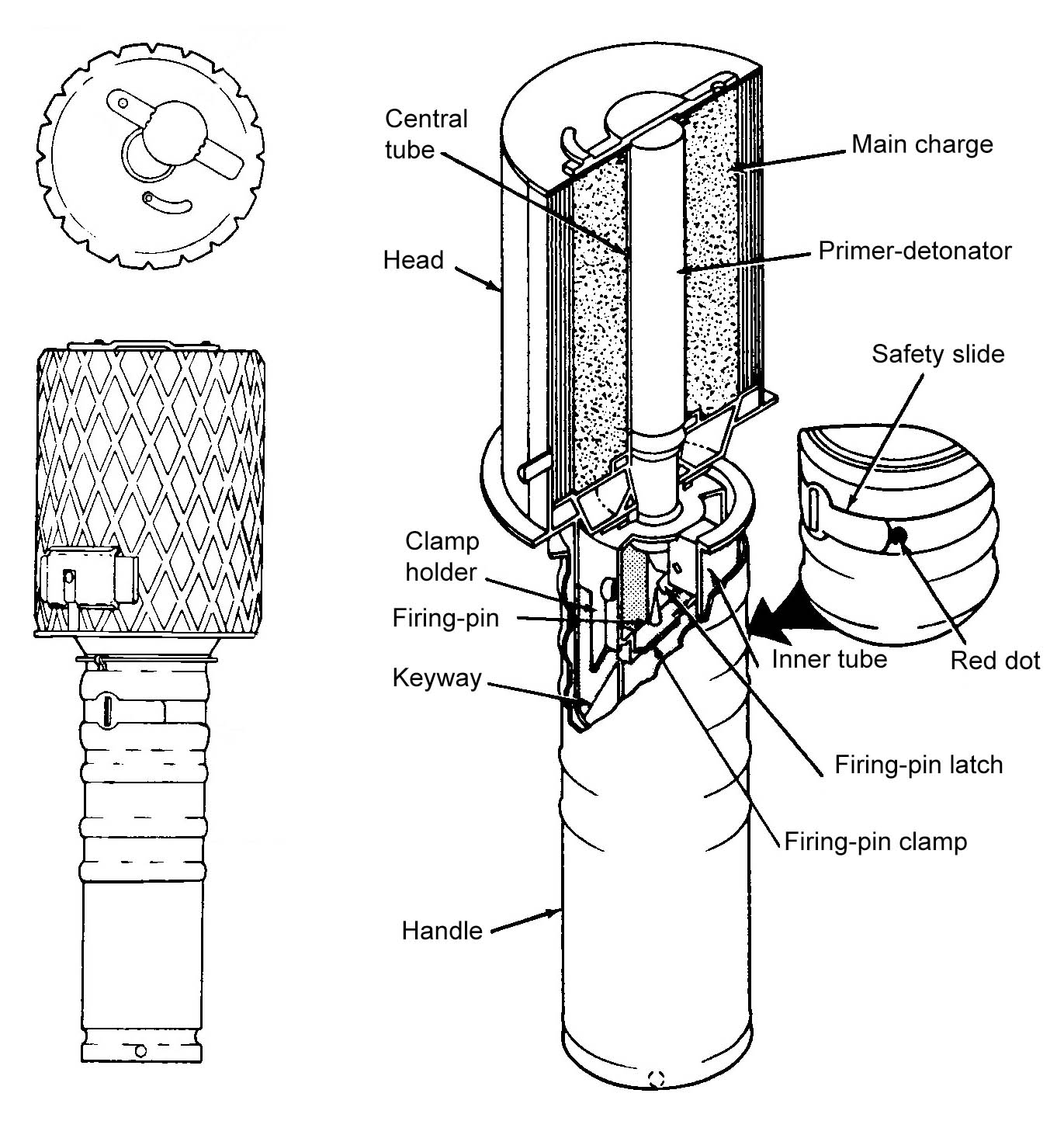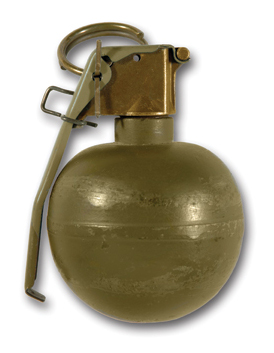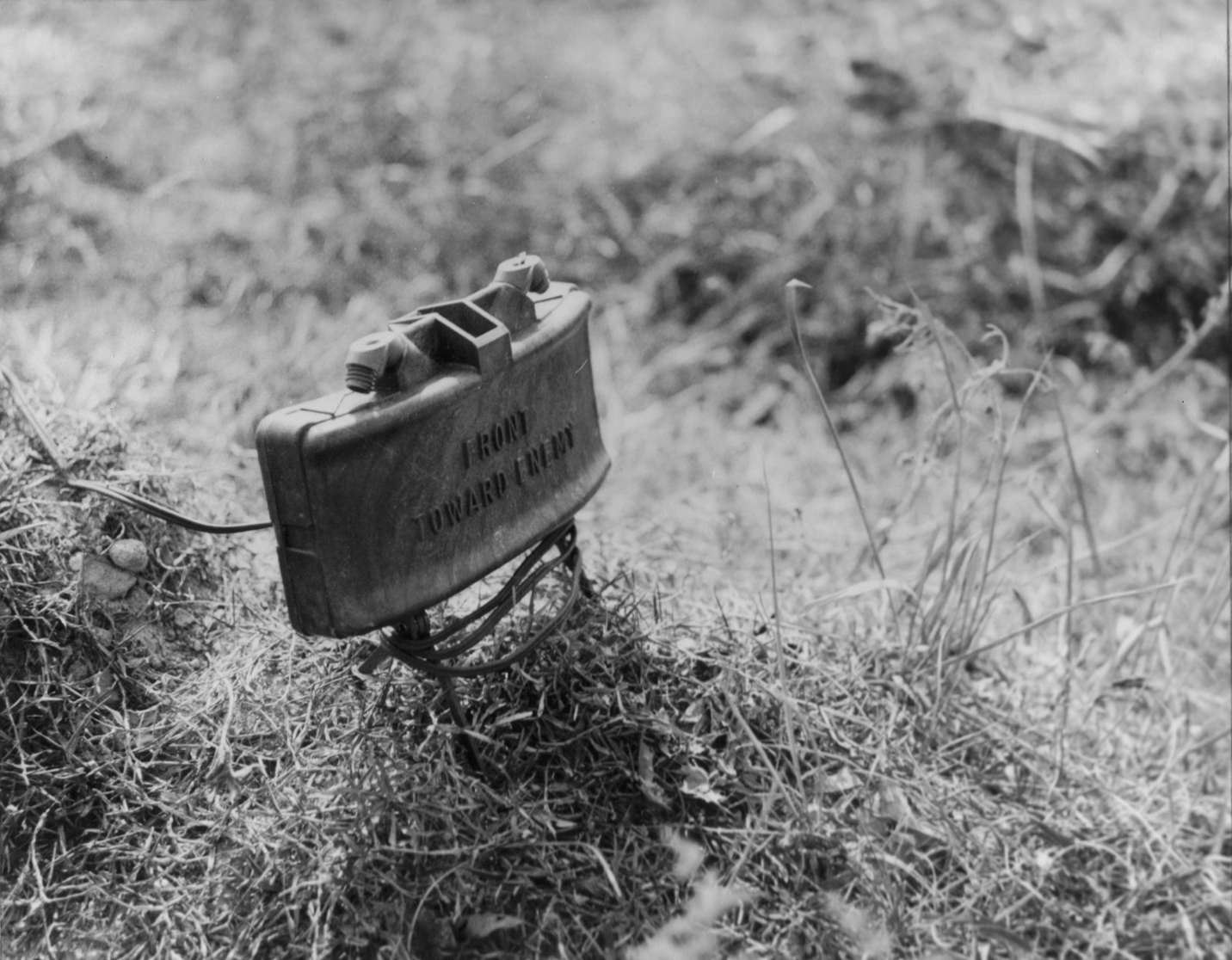|
RGD-33
The Soviet RGD-33 (''Ручная Граната Дьяконова образца 33 года'' >''Ruchnaya Granata Djakonova obraztsa 33 goda'', "Hand Grenade, Dyakonov design, pattern year 93") is an anti-personnel fragmentation stick grenade developed in 1933. The grenade was composed of three separate pieces that were stored in different crates until use: the warhead and sleeve, spring-loaded handle, and fuze tube. They were assembled and issued only before combat. The warhead and handle were screwed together and carried in a grenade pouch and the fuzes were wrapped in waxed paper and carried separately in the pouch's internal pocket. There was a hole in the outer handle to the right of the thumb catch that lined up with bars of paint on the inner handle, making a colored dot - a white dot meant safe and a red dot meant the handle assembly was cocked. It would not be armed unless the fuze tube had been inserted, which would be done only before throwing. Use Before armi ... [...More Info...] [...Related Items...] OR: [Wikipedia] [Google] [Baidu] |
RGD-33 Grenade And Cutaway
The Soviet RGD-33 (''Ручная Граната Дьяконова образца 33 года'' >''Ruchnaya Granata Djakonova obraztsa 33 goda'', "Hand Grenade, Dyakonov design, pattern year 93") is an anti-personnel fragmentation stick grenade developed in 1933. The grenade was composed of three separate pieces that were stored in different crates until use: the warhead and sleeve, spring-loaded handle, and fuze tube. They were assembled and issued only before combat. The warhead and handle were screwed together and carried in a grenade pouch and the fuzes were wrapped in waxed paper and carried separately in the pouch's internal pocket. There was a hole in the outer handle to the right of the thumb catch that lined up with bars of paint on the inner handle, making a colored dot - a white dot meant safe and a red dot meant the handle assembly was cocked. It would not be armed unless the fuze tube had been inserted, which would be done only before throwing. Use Before arming ... [...More Info...] [...Related Items...] OR: [Wikipedia] [Google] [Baidu] |
Model 1914 Grenade
The Model 1914 grenade (''Ручная граната образца 1914 года'' > ''Ruchnaya granata obraztsa 1914 goda'', "Hand Grenade Pattern of year 1914") is a Russian stick concussion grenade (fragmentation grenade via an optional jacket) that was used during World War I and World War II. Operation The M1914 is a time-delayed grenade. To activate it, the user must hold the grenade with the safety pin between two fingers, move the safety catch so that it is away from the hammer's front, then throw it. The safety pin is released as soon as the grenade is thrown. History Origins The M1914 is a heavily modified Model 1912 grenade. The head of the grenade went from a box to a cylinder, the wooden handle was removed in favor of a welded sheet of metal and the belt hook was removed. World War I The M1914 was one of the few grenades used the conflict that was in service before the war started. It was used throughout the war, along with the Stender grenade, by Russian forces ... [...More Info...] [...Related Items...] OR: [Wikipedia] [Google] [Baidu] |
Hand Grenade
A grenade is an explosive weapon typically thrown by hand (also called hand grenade), but can also refer to a shell (explosive projectile) shot from the muzzle of a rifle (as a rifle grenade) or a grenade launcher. A modern hand grenade generally consists of an explosive charge ("filler"), a detonator mechanism, an internal striker to trigger the detonator, and a safety lever secured by a cotter pin. The user removes the safety pin before throwing, and once the grenade leaves the hand the safety lever gets released, allowing the striker to trigger a primer that ignites a fuze (sometimes called the delay element), which burns down to the detonator and explodes the main charge. Grenades work by dispersing fragments ( fragmentation grenades), shockwaves ( high-explosive, anti-tank and stun grenades), chemical aerosols ( smoke and gas grenades) or fire ( incendiary grenades). Fragmentation grenades ("frags") are probably the most common in modern armies, and when t ... [...More Info...] [...Related Items...] OR: [Wikipedia] [Google] [Baidu] |
RG-42
The Soviet RG-42 (Ручная Граната образца 42 года > ''Ruchnaya Granata obraztsa 42 goda'', "Hand Grenade pattern of 92 year") was a fragmentation grenade designed by S.G. Korshunov. It was originally introduced during World War II from 1942 onwards as an emergency measure to replace the complex RGD-33 grenade. It continued in use with the USSR and its Warsaw Pact allies in the post-war period until replaced in 1954 by the RGD-5 grenade. Stockpiles were held for emergency or reserve issue, military aid, or foreign sales. They were eventually destroyed in the 1980s due to the TNT filling degrading and becoming unsafe. Unlike the RGD-33, the RG-42's components were simple to produce and assemble. Only the fuze required specialized manufacture and the parts could be easily assembled by hand by cottage labor. Partisans often made copies of the simple design when out of contact. It contained about 200 grams of explosive charge ( TNT) in a cylindrical stamped ... [...More Info...] [...Related Items...] OR: [Wikipedia] [Google] [Baidu] |
Grenade
A grenade is an explosive weapon typically thrown by hand (also called hand grenade), but can also refer to a shell (explosive projectile) shot from the muzzle of a rifle (as a rifle grenade) or a grenade launcher. A modern hand grenade generally consists of an explosive charge ("filler"), a detonator mechanism, an internal striker to trigger the detonator, and a safety lever secured by a cotter pin. The user removes the safety pin before throwing, and once the grenade leaves the hand the safety lever gets released, allowing the striker to trigger a primer that ignites a fuze (sometimes called the delay element), which burns down to the detonator and explodes the main charge. Grenades work by dispersing fragments ( fragmentation grenades), shockwaves ( high-explosive, anti-tank and stun grenades), chemical aerosols ( smoke and gas grenades) or fire ( incendiary grenades). Fragmentation grenades ("frags") are probably the most common in modern armies, and when the w ... [...More Info...] [...Related Items...] OR: [Wikipedia] [Google] [Baidu] |
Fragmentation Grenades
A grenade is an explosive weapon typically thrown by hand (also called hand grenade), but can also refer to a shell (explosive projectile) shot from the muzzle of a rifle (as a rifle grenade) or a grenade launcher. A modern hand grenade generally consists of an explosive charge ("filler"), a detonator mechanism, an internal striker to trigger the detonator, and a safety lever secured by a cotter pin. The user removes the safety pin before throwing, and once the grenade leaves the hand the safety lever gets released, allowing the striker to trigger a primer that ignites a fuze (sometimes called the delay element), which burns down to the detonator and explodes the main charge. Grenades work by dispersing fragments ( fragmentation grenades), shockwaves ( high-explosive, anti-tank and stun grenades), chemical aerosols (smoke and gas grenades) or fire (incendiary grenades). Fragmentation grenades ("frags") are probably the most common in modern armies, and when the word ''gr ... [...More Info...] [...Related Items...] OR: [Wikipedia] [Google] [Baidu] |
Model 24 Grenade
''Stielhandgranate'' is the German term for "stick hand grenade" (translation: "shaft hand grenade") and generally refers to a prominent series of World War I and World War II-era German stick grenade designs, distinguished by their long wooden handles, pull cord arming and cylindrical warheads. The first models were introduced by the Imperial German Army during World War I and the final design was introduced during World War II by the German Wehrmacht. The distinctive appearance of the stielhandgranate-family has led to them being called "potato mashers" in British Army slang, and they remain one of the most easily recognized infantry weapons of the 20th century. World War I models: 1915–1917 Germany entered World War I with a single grenade type: a heavy ball-shaped fragmentation grenade ('' Kugelhandgranate'') for use only by pioneers in attacking fortifications. It was too heavy for regular battlefield use by untrained troops and not suitable for mass p ... [...More Info...] [...Related Items...] OR: [Wikipedia] [Google] [Baidu] |
World War II
World War II or the Second World War, often abbreviated as WWII or WW2, was a world war that lasted from 1939 to 1945. It involved the vast majority of the world's countries—including all of the great powers—forming two opposing military alliances: the Allies and the Axis powers. World War II was a total war that directly involved more than 100 million personnel from more than 30 countries. The major participants in the war threw their entire economic, industrial, and scientific capabilities behind the war effort, blurring the distinction between civilian and military resources. Aircraft played a major role in the conflict, enabling the strategic bombing of population centres and deploying the only two nuclear weapons ever used in war. World War II was by far the deadliest conflict in human history; it resulted in 70 to 85 million fatalities, mostly among civilians. Tens of millions died due to genocides (including the Holocaust), starvation, massa ... [...More Info...] [...Related Items...] OR: [Wikipedia] [Google] [Baidu] |
Korean War
, date = {{Ubl, 25 June 1950 – 27 July 1953 (''de facto'')({{Age in years, months, weeks and days, month1=6, day1=25, year1=1950, month2=7, day2=27, year2=1953), 25 June 1950 – present (''de jure'')({{Age in years, months, weeks and days, month1=6, day1=25, year1=1950) , place = Korean Peninsula, Yellow Sea, Sea of Japan, Korea Strait, China–North Korea border , territory = Korean Demilitarized Zone established * North Korea gains the city of Kaesong, but loses a net total of {{Convert, 1506, sqmi, km2, abbr=on, order=flip, including the city of Sokcho, to South Korea. , result = Inconclusive , combatant1 = {{Flag, First Republic of Korea, name=South Korea, 1949, size=23px , combatant1a = {{Plainlist , * {{Flagicon, United Nations, size=23px United Nations Command, United Nations{{Refn , name = nbUNforces , group = lower-alpha , On 9 July 1951 troop constituents were: US: 70.4%, ROK: 23.3% other UNC: 6.3%{{Cite ... [...More Info...] [...Related Items...] OR: [Wikipedia] [Google] [Baidu] |
Vietnam War
The Vietnam War (also known by other names) was a conflict in Vietnam, Laos, and Cambodia from 1 November 1955 to the fall of Saigon on 30 April 1975. It was the second of the Indochina Wars and was officially fought between North Vietnam and South Vietnam. The north was supported by the Soviet Union, China, and other communist states, while the south was supported by the United States and other anti-communist allies. The war is widely considered to be a Cold War-era proxy war. It lasted almost 20 years, with direct U.S. involvement ending in 1973. The conflict also spilled over into neighboring states, exacerbating the Laotian Civil War and the Cambodian Civil War, which ended with all three countries becoming communist states by 1975. After the French military withdrawal from Indochina in 1954 – following their defeat in the First Indochina War – the Viet Minh took control of North Vietnam, and the U.S. assumed financial and military support for the South Vietnames ... [...More Info...] [...Related Items...] OR: [Wikipedia] [Google] [Baidu] |
Trinitrotoluene
Trinitrotoluene (), more commonly known as TNT, more specifically 2,4,6-trinitrotoluene, and by its preferred IUPAC name 2-methyl-1,3,5-trinitrobenzene, is a chemical compound with the formula C6H2(NO2)3CH3. TNT is occasionally used as a reagent in chemical synthesis, but it is best known as an explosive material with convenient handling properties. The explosive yield of TNT is considered to be the standard comparative convention of bombs and asteroid impacts. In chemistry, TNT is used to generate charge transfer salts. History TNT was first prepared in 1863 by German chemist Julius Wilbrand and originally used as a yellow dye. Its potential as an explosive was not recognized for three decades, mainly because it was too difficult to detonate because it was less sensitive than alternatives. Its explosive properties were first discovered in 1891 by another German chemist, Carl Häussermann. TNT can be safely poured when liquid into shell cases, and is so insensitive that ... [...More Info...] [...Related Items...] OR: [Wikipedia] [Google] [Baidu] |
Anti-personnel
An anti-personnel weapon is a weapon primarily used to maim or kill infantry and other personnel not behind armor, as opposed to attacking structures or vehicles, or hunting game. The development of defensive fortification and combat vehicles gave rise to weapons designed specifically to attack them, and thus a need to distinguish between those systems and ones intended to attack people. For instance, an anti-personnel landmine will explode into small and sharp splinters that tear flesh but have little effect on metal surfaces, while anti-tank mines have considerably different design, using much more explosive power to effect damage to armored fighting vehicles, or use explosively formed penetrators to punch through armor plating. Many modern weapons systems can be employed in different roles. For example, a tank's main gun can fire armor-piercing ammunition in the anti-tank role, high-explosive ammunition in the anti-structure role and fragmentation shells in the anti-perso ... [...More Info...] [...Related Items...] OR: [Wikipedia] [Google] [Baidu] |

.jpg)



.jpg)




